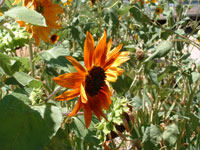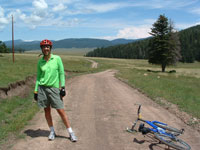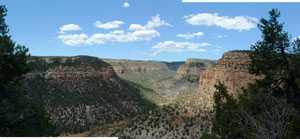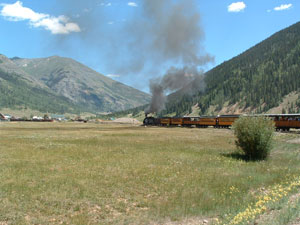Rich -
For an accessible introduction to quantum computing, you might try George Johnson's A Shortcut Through Time. In addition to being a terrific introduction to the topic, it's a delightful read.
"Our Diner, who art in Hillsville,
hallowed be thy name.
Thy hash browns come,
Thy eggs be done,
with toast as it is on th' menu.
Give us this day our Daily Special,
and forgive us our offgases as we forgive those who offgas against us.
And lead us not into McDonalds,
but deliver us from Wendy's,
for thine is the Cheesedog,
and the Pepsi,
and the Liver and Onions,
forever and ever.
Amen."
- Zippy
I have always loved the strange and wonderful tale of Lewis Fry Richardson, the British scientist who spent much of World War I driving an ambulance and calculating, by hand, a one-day weather forecast.
That obviously was not practical, so Richardson dreamed up a stadium-sized room full of "computers" (they were people who computed back then), doing their calculations and passing paper back and forth among their neighbors.
The architecture of Sandia National Laboratories new Red Storm supercomputer is very Richardson-like (lots of near-neighbor message passing), so I took the opportunity for an extended riff.
Lissa notes the old saw that human hair will keep deer out of your garden. For several years she's been cutting my hair in the backyard, leaving the clippings laying about. We have had no deer. QED.
In which our Dreadlocked Flaneur goes Hollywood. I hope you'll still remember the little people, Gene....
Being the worry wart that I am, I've got to find something associated with my upcoming race to vex about.
How about the weather? Talking to one of my weather friends last week, I learned that the longest-range model, the Global Forecast System model run by the U.S. government's National Center for Environmental Prediction, shows a big storm headed our way, rolling up off of the coast of Central America and heading north, until it gets caught up in the westerlies.
So now every morning I fire up the model page to see when the storm's forecast to get here. It looks like it has the potential to be an impressive storm, but this morning the model run I look at shows it just reaching our southern border by race day. Yay.
It will be interesting to see how this effort to shut down New York during the RNC works. (Thanks to Nora for the link.)
If you want to have a bike race, sometimes you've got to work with what's available. (Warning, broadband recommended, 51.5 meg file, and by "don't do this at home," I mean the grabbing hold of cars and going the wrong way down streets when cars are there, not the drag part. Riding in drag is OK.)
More on the film in Knot Magazine.
I love these people:
The Independent Investigations Group has been examining the public claims of Carla Baron – a self-proclaimed “psychic detective” who has solved fifty cases in the past twenty years, or has solved no cases in the past three years, depending on whether you believe her or us.
(Link from Dave Thomas.)
David Appell commented earlier this week on the moment when you realize it's fall:
Every year it's the middle of August plus a few days. In mid-August there's inevitably a several days-long rain, followed by a clearing in which the climate is suddenly different -- clear blue skies, significantly less humid, cooler, especially at night. This year was no different, and the change is palpable....
He's up in New Hampshire, and I infer that fall seems to herald for him some unpleasantness - "all too soon" - whereas here it's a sort of soft and comforting blanket being gently draped about our shoulders. I love that moment when it suddently snaps - a subtle meteorological phenomenon, but a clear mental step function.
In Albuquerque, we demonstrably had it Wednesday morning, if I can gunk up the romantic feeling of cool mornings and the smell of roasting chiles with the practical empiricism of meteorology. The summer high that wobbles around the southwest like a wandering drunk is pretty much gone, replaced by the upper-level westerlies that dominate fall and winter. Overnight lows have slipped into the '50s and the first chile-roasting picture has appeared on the front page of the newspaper.
The westerlies brought in a cloud cover Wednesday that would be unheard of under the summer high, and the low of 52 Wednesday morning was a record. This is all vaguely early - the summer high and the resulting monsoons often linger into the first week of September. But the kids are back in school, the state fair starts next week, and I can see some yellowing leaves on the big cottonwood across the street, so I guess it makes sense to get on with things.
In which I get my big chance to write about saguaros.
For another take on the issue, try this. Or this.
My friend Maggie's group "Holy Water and Whiskey" will do its apparently political thing (I've never heard 'em, but I know Maggie :-) tonight at 8 p.m. MDT on KUNM. That's 89.9 FM for you Albuquerqueans (but y'all already knew that) and streaming on the web for those of you not lucky enough to live around here.
"Is it a meteor from Mars or excrement from earthlings?"

OK, I've been sort of flip here the last few days about this weed thing, but y'all have to seriously understand the depth of my passion on this subject. It must not be minimized:
Key to understanding Weed Man is understanding the touch, sometimes light and sometimes heavy, he places upon his garden ecosystem. A weed in the right place is transformed into a plant, and is gently spared and watered. A weed in the wrong place must go. But there is always the fascination - why this spot? Why this weed?
Take the sunflower.
Our garden right now is, in several places, a forest of sunflowers. Some are feral, the offspring of old hybrids (the big seedhead kind) that have drifted back to their wild type. Some are planted new this year, autumn beauties (I think that's the name - some a rich velvety brown, some tinted yellow toward the edges and brown at the center) that Nora gave her mom for Mother's Day.
Out my office window, the backyard is dotted with yellow, the sunflowers buzzing with bees if you get up close. I'm pretty sure not a one out there got planted this year. All are spawn of last year's offal. Out front, Lissa and I were sitting this morning on the porch watching a little finch of some kind sitting on a sunflower plant - light enough not to bend the stalk - and leaning over the flower into the seedhead for a snack.
(John Bohnsack has nicer Albuquerque flowersthan mine.)
OK, if I was a bike racer, does that mean I would spend the time to swap out my heavy, goathead resistant training tires for something lighter when I race? Even if it's just a "B" race, a tuneup?
If I was a bicyclist, husband, friend, does that mean I'd go for a lovely long slow ride with my wife on a sunny Sunday late summer morning?
But what if I realized halfway through that I still had my racing tires on the bike?
P.S. This morning, I pulled weeds from the garden.
My beloved just fried up a big pan of potatoes and onions for breakfast.
The smell of Walla Walla sweet onions in the morning makes me feel loved.
It would be misleading to tell you that I placed eighth in my age group in the state time trial championships this morning, without also pointing out that there were only ten people entered in my age group. But it would not be misleading to tell you that I rode what on my terms was a terrific race, my fastest time trial performance and a perfect setup for Moriarty two weeks hence.
The race was 20 km (12+ miles), with almost no wind and a flat-to-slightly rolling course. It's across open country on Albuquerque's west mesa, skirting the edge of a clump of dinky volcanoes, up alongside a small general aviation airport called Double Eagle.
The trick in a time trial is to flirt with the edge of the anaerobic threshhold:

That for me is between 167 and 170 hearbeats per minute, and you can see from the graph that aside from a few moments of uncertainty and lost concentration I had it pretty much locked in. (The big sagging tail on the right after 34 minutes is warmdown.) It took about 10 or 11 minutes to get settled, and then it just felt right.
34:17 officially, just a hair under 22 mph - damn slow by the big boys' standards, but the fastest in my brief time trialling career.
I stumbled across this bit of history this morning - the first web page I ever helped build.
Comet Hale-Bopp was, at the time, one of the coolest stories I'd ever had the privilege to be involved in, science you could go out and see for yourself, and this new Web thing was about the coolest medium for more fully sharing my excitement with others. We were as young and naive as the medium, but we had fun that year and my enthusiasm for the Web as a medium for sharing my work hasn't waned.
Am I a journalist? What kind?
Or am I a writer? What kind?
A cyclist? A bike racer?
A friend, husband, father, son?
Or is it most important that I simply pull weeds from the garden?
Dogbert: Function means nothing. Design is everything.
Here in New Mexico, we take our cacti seriously.
Or maybe the cowpoke is just wondering: Where did these saguaros come from?
The southwestern travelogue continues, this week taking us to the Valles Caldera, where Lissa and I took advantage of their decision to cautiously open things up for a mountain biking experiment this weekend.
We pronounce the experiment a success, though the fact that we don't really mountain bike made even the beginner trail a bit arduous.
I once described the Caldera as being, to a geologist, like "a secular sort of sacred ground." It was there, in a volcanic formation, that Brent Dalrymple in the 1960s found the rocks that clinched the deal for the theory of plate tectonics, launching a revolution in earth science.
For that alone the Valles would be a spectacular place, but there's so much more. Created in a massive volcanic eruption 1.2 million years ago that created a crater 15 miles wide, the Caldera is a geologic wonder. There's no place short of an airplane where you can see the whole thing, because subsequent volcanic eruptions dotted the crater with massive volcanic humps. The humps are covered with pines (it was one of the humps on which Dalrymple found his Rosetta Stone), and beautiful meadowed valleys thread among them.
The problem is that until recently the bulk of the Caldera was in private hands. The federal government bought the land in July 2000, setting up a trust to administer it. It remains a working ranch, and public access is being slowly introduced, with an eye toward finding ways to let us in without screwing the place up.
This weekend's mountain biking was one such experiment. They opened several routes, from the relatively less hard to the relatively more hard, along the old logging roads that cover the Caldera. They limited the numbers, and sold tickets. It wasn't cheap - $20 each. But since the whole point of the Valles experiment in federal land management is to try to find ways for preservation to pay for itself, I didn't mind.
Our ride took us across the main valley (that's what you see in the background in the photo above) and up into the woods for a long, level traverse of one of the volcanic humps.
Red-winged blackbirds were everywhere in the valley, and mountain bluebirds. "If I was a bird, I'd live here," Lissa said. We didn't see any elk, but we could, uh, tell they had been there. (Last time I was there, when I went for the story linked above, we saw a huge herd of elk as we were leaving the place. Magnificent.)
mjh: No worries. It's your job to reflexively attack and mine to reflexively defend. Keep holding up your end, and I'll keep trying to hold up mine.
mjh - It's fallacious to pick a single day's paper and try to say anything useful about fairness and balance, any more than I could pick a single rainy day and say that the drought's over. Take a couple of weeks' coverage, do an honest assessment of postive/negative Bush/Kerry coverage and then you might have something.
My personal experience as, to borrow Clandestino's phrase, "one who works in a local newsroom," is that readers with strong views on any polarized issue tend to view the newspaper as strongly biased against them and in favor of their opponents, no matter what we do. Rush Limbaugh and Amy Goodman have both made a cottage industry out of this truism - though Rush's cottage seems quite a bit larger.
Earlier in the week I mentioned drought at Mesa Verde. Now that we're back and I've had time to collect my thoughts and do more research, there's a bit more to say.
This is my best attempt (sorry, I'm not much of a photographer) to capture the piñon dieoff that we saw. This picture is overlooking Spruce Tree House (you can see a bit of the cliff dwelling in the shadoes on the right).
The dead trees are a function of drought. Bark beetles do the killing, but they prey on stressed trees, which don't have enough sap to repel them. All over Mesa Verde, fire has been widespread over the last five years, which is also a function of drought. What forest hadn't burned was dotted with dead trees. This might sound depressing - and might explain the fact that there seemed to be far fewer visitors this year than we remembered in years past. But to me, as a student of drought phenomena, it was fascinating.
Here are some numbers for Mesa Verde:
Average annual precip, 1948 - present: 17.81 inches
Average annual precip, 1991-1998 (the years we became accustomed to things there): 20.3 inches
Average annuual precip, 1999-2003: 13.35 [1]
In other words, precip at Mesa Verde over the last five years is just 75 percent of average, and just 66 percent of what we'd come to expect as normal based on the years we've been going there. This is beyond merely the odd stochastic dry year. This is cumulative, five straight dry years.
Given my traditional definition of drought as being "less rain than you've come to expect," or, more precisely for people actually impacted by the drought rather than those like me who just watch it, "less rain than you've come to rely on," you can see why Mesa Verde looks and acts pretty damn dry to us right now.
[1] Thanks once again to the fine folks at the Western Regional Climate Center for their amazing work making data sets available to the public.
Lissa and I slipped away for a lovely few days on the road, up in southern Colorado.
We camped at Mesa Verda, a favorite spot as much any more for the beautiful piñon-juniper woodlands as the ruins. It's on top of a gently tilting mesa, rising up out of the San Juan Basin into the foot of the San Juans, the rugged southwestern corner of the Rocky Mountains. It's been wracked by fire and drought over the last four or five years, but if anything that makes it more interesting. We've been going long enough that we can see and understand the change.
We spent some time hiking on the mesa, and also took a day to drive up from Durango over Coal Bank Pass to Silverton, some real-deal mountains (Coal Bank Pass is 10,640 feet.).
A bit of serendipity also landed us in Farmington, New Mexico, in time for the town's parade celebrating the start of the 40th annual Connie Mack World Series. In addition to baseball players, there was a remarkable person in an inflatable smoothie costume:
I pronounce my Google experiment a success. I am now the number one search result for "sufficiently obscure".
A glance at Inkstain's server logs this morning showed a big increase in traffic yesterday, which seems to have come from a bot at Turnitin.com. Apparently they offer services for educators who want to detect and deter plagiarism by students.
Pity the poor kid who plagiarizes from my blog - but for more reasons than just that.
The path of Hurricane Alex starts to look interesting for those of you in northern Europe.
I was surprised to note that if one Googles more balloons, my blog entry of last week is the second hit. Given the possible permutations available in our language, it occurs to me that this is likely to happen with any two-word phrase that is sufficiently obscure.
The available evidence suggests there's some validity to my hypothesis. Consider this a test.
More stuff on my planet: blogs from Hallski, Eric Baudais and Rosanna Yuen, and Pika's RSS feed is fixed (which is to say that my boneheaded error is fixed, seems her feed was actually probably working the whole time). And I removed the hurricane warnings. They were truly a bit much.
This posting is a community experiment that tests how a meme, represented by this blog posting, spreads across blogspace, physical space and time. It will help to show how ideas travel across blogs in space and time and how blogs are connected. It may also help to show which blogs are most influential in the propagation of memes. The dataset from this experiment will be public, and can be located via Google (or Technorati) by doing a search for the GUID for this meme (below).
The original posting for this experiment is located at: Minding the Planet (Permalink: http://novaspivack.typepad.com/nova_spivacks_weblog/2004/08/a_sonar_ping_of.html) --- results and commentary will appear there in the future.
Please join the test by adding your blog (see instructions, below) and inviting your friends to participate -- the more the better. The data from this test will be public and open; others may use it to visualize and study the connectedness of blogspace and the propagation of memes across blogs.
The GUID for this experiment is: as098398298250swg9e98929872525389t9987898tq98wteqtgaq62010920352598gawst (this GUID enables anyone to easily search Google (or Technorati) for all blogs that participate in this experiment). Anyone is free to analyze the data of this experiment. Please publicize your analysis of the data, and/or any comments by adding comments onto the original post (see URL above). (Note: it would be interesting to see a geographic map or a temporal animation, as well as a social network map of the propagation of this meme.)
INSTRUCTIONS
To add your blog to this experiment, copy this entire posting to your blog, and then answer the questions below, substituting your own information, below, where appropriate. Other than answering the questions below, please do not alter the information, layout or format of this post in order to preserve the integrity of the data in this experiment (this will make it easier for searchers and automated bots to find and analyze the results later).
REQUIRED FIELDS (Note: Replace the answers below with your own answers)
(1) I found this experiment at URL: http://pharyngula.org/
(2) I found it via "Newsreader Software" or "Browsing the Web" or "Searching the Web" or "An E-Mail Message": "Browsing the Web"
(3) I posted this experiment at URL: http://www.inkstain.net/fleck/
(4) I posted this on date (day, month, year): 03/08/04
(5) I posted this at time (24 hour time): 12:29:00
(6) My posting location is (city, state, country): Albuquerque, NM, USA
OPTIONAL SURVEY FIELDS (Replace the answers below with your own answers):
(7) My blog is hosted by: Southwest Cyberport
(8) My age is: 45
(9) My gender is: Male
(10) My occupation is: Journalist
(11) I use the following RSS/Atom reader software:
(12) I use the following software to post to my blog: Movable Type
(13) I have been blogging since (day, month, year): 19/03/2001
(14) My web browser is: Firebird
(15) My operating system is: Linux
The first tropical storm of the seasoon is rolling up the U.S. east coast, one of those shore-skimmers.
Hey you Americans in the audience, listen to the words of our discombobulated Aussie visitor:
Everything is big - if not in size, then in volume or sheer in-your-face-ness. The cars are huge, though you could scarcely describe them as cars. The television in my hotel room is almost twice the size of our TV at home. The convenience store is a kidney-punch of choice and product.
If it's any consolation, Jeff, we went with the small TV.
So I guess I wasn't really a geek until today.
I set up a Paypal account.
I made my first Ebay purchase.
All for a Gmail account, which seems like a promising toy. "jfleck" was already gone, so I got "jrfleck". Drop me a line. I'll archive it forever.




